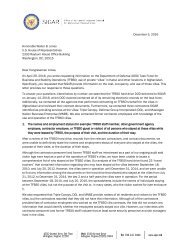SIGAR
2016-04-30qr
2016-04-30qr
Create successful ePaper yourself
Turn your PDF publications into a flip-book with our unique Google optimized e-Paper software.
Security: The eroding bedrock<br />
• Director of National Intelligence James Clapper testified before the<br />
U.S. Senate Intelligence Committee in March that “fighting in 2016<br />
will be more intense than 2015, continuing a decade-long trend of<br />
deteriorating security.” 5<br />
• The UN Secretary-General’s Special Representative for Afghanistan<br />
told the Security Council in March that “For 2016, survival will be an<br />
achievement for the [Afghan] National Unity Government.” 6<br />
• On April 12, the Taliban announced the start of another spring<br />
offensive, pledging assaults against government strongholds and suicide<br />
and guerrilla attacks. 7 This year’s offensive may reflect a new dynamic.<br />
An RS spokesman said the Taliban is developing a relationship with<br />
al-Qaeda elements, who can “serve as an accelerant” because of their<br />
“very special skills.” 8<br />
Afghan National Army noncommissionedofficer<br />
candidates stand in formation.<br />
(ISAF photo by MC2 Eliezer Gabriel)<br />
Providing effective security is indeed essential for the survival of the<br />
Afghan state—and for the success of the reconstruction effort. Neither can<br />
deliver lasting gains without the other. As Ohio State University militaryhistory<br />
professor and retired Army colonel Peter Mansoor has observed:<br />
“Military victory alone did not ensure that Germany, Italy, and Japan would<br />
emerge from [World War II] as liberal democracies committed to prosperity<br />
and human rights at home and a liberal world order abroad. It was, rather,<br />
the presence of US military forces, economic aid, and a political commitment<br />
from American policymakers to rebuild and restore these nations that<br />
ensured an enduring peace.” 9<br />
A similar engagement is under way in Afghanistan. The 2015 White<br />
House National Security Strategy notes that the United States has “transitioned<br />
to a dramatically smaller force”—and immediately adds that<br />
the force is “focused on the goal of a sovereign and stable partner in<br />
Afghanistan that is not a safe haven for international terrorists.” 10 That<br />
goal is more than a purely military matter. A March 2016 conference on<br />
Afghanistan hosted by the U.S. Institute of Peace, Stanford University, and<br />
the UK’s Royal Institute for International Affairs produced a consensus that<br />
securing and securing gains in Afghanistan “starts but does not end” with<br />
the ANDSF. Conferees, who included officials, scholars, and former U.S.<br />
Ambassador James Dobbins, recommended “long-term, predictable support,”<br />
adding that “Throughout history, Afghan governments have fallen<br />
when external support has been withdrawn.” 11<br />
Given the bedrock importance of security to Afghanistan reconstruction—especially<br />
as reductions in international support and advisory forces<br />
continue—continuing these examinations is a critical mission in itself.<br />
Since <strong>SIGAR</strong> was created in 2008, it has released 74 reports examining how<br />
funds appropriated for the ANDSF have been used. That work continues in<br />
an atmosphere of deteriorating security.<br />
4<br />
Special inspector general I Afghanistan reconstruction




